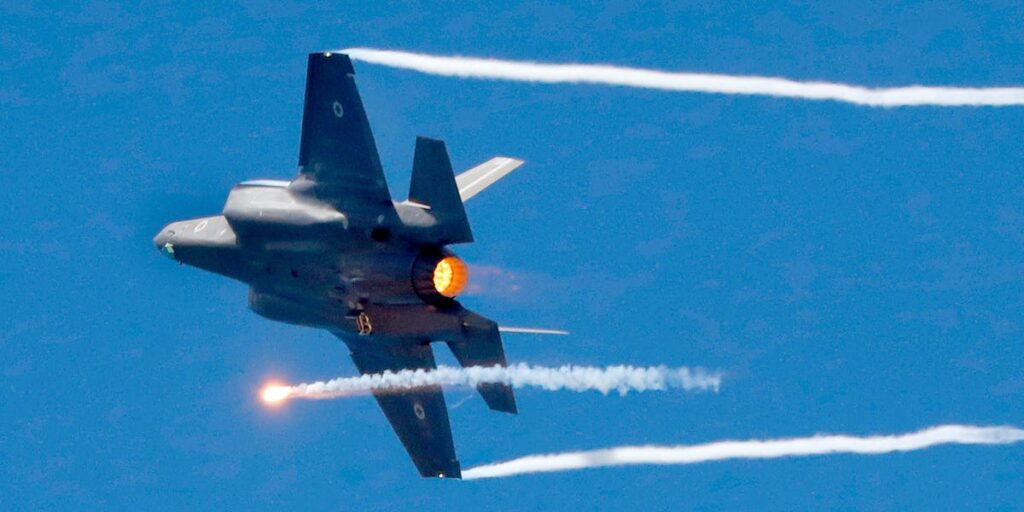- F-35 combat operations have often been against terrorist and militant targets.
- Israel used the fighter jet in widespread strikes against Iran in late October.
- The success of that operation underscores the F-35’s ability to battle higher-level threats.
F-35 stealth fighters have been flying combat missions in the Middle East for years now, though largely in permissive airspace against lower-level targets. The jet’s recent victory against Iran’s air defenses, however, highlights its ability to combat higher-level threats.
Britain’s top military officer shared last week that when Israel used its fifth-generation F-35s to execute retaliatory strikes against Iran in late October, it wiped out nearly all of Tehran’s air defenses and hammered its missile production sites.
The suppression and destruction of enemy air defenses through penetrating strikes — that is the kind of higher-level mission for which the jet was made.
The F-35 has historically been used against weaker targets with either limited or nonexistent air defenses. Israeli F-35s have previously battled Syrian surface-to-air missiles and antiaircraft batteries and engaged in strikes on Iranian targets, but the expensive fighter jet has largely been employed against non-state actors like ISIS, the Taliban, and the Houthis.
Israel’s recent operation against Iran, which fielded very capable Russian-made surface-to-air missile systems, emphasizes how the jet is capable of engaging in combat at a higher level.
Mark Gunzinger, a retired US Air Force colonel who flew the B-52 Stratofortress bomber, told Business Insider that without the F-35, it would’ve probably been “a far more risky mission.”
The ‘power’ of the F-35
The F-35 Lightning II Joint Strike Fighter is an advanced single-engine, multi-role strike stealth fighter jet made by American defense contractor Lockheed Martin. Multiple variants of the aircraft are in use by several countries, including Israel.
Michael Bohnert, a licensed engineer at the RAND Corporation, said that the F-35 was designed to replace existing fighter jets like the F-117, F-16, and F/A-18 with increased stealth, ISR (intelligence, surveillance, and reconnaissance), and other capabilities.
“The F-35 is a great plane conceived out of the 1990s Pax Americana,” Bohnert told BI.
Israel, which operates a subvariant of the F-35A model designed for air force operations, was the first to fly the fighter jet in combat in 2018. The US military has since used it in missions across the Middle East.
The F-35 fighter faced probably its most daring operation in late October, when Israel struck Iran in response to Tehran’s huge missile attack at the start of the month.
“Israel used more than 100 aircraft, carrying fewer than 100 munitions, and with no aircraft getting within 100 miles of the target in the first wave, and that took down nearly the entirety of Iran’s air-defense system,” said Adm. Tony Radakin, the UK’s chief of defense staff.
Radakin, speaking in London at a December 4 lecture hosted by the Royal United Services Institute, said Israel demonstrated “the power” of jet and the “disproportionate advantage of modern ways of fighting” in its strikes against Iran.
His remarks appeared to mark the first confirmation from a Western government that Israel used the fifth-generation aircraft in the strikes. It was reported shortly after the operation that Israel flew its F-35s and fired air-launched ballistic missiles.
Radakin’s praise of the F-35 came after Elon Musk criticized the jet and dismissed its stealth capabilities. The aircraft is the Pentagon’s most expensive weapons program, but it is widely considered a key warfighting capability for US allies and partners.
The F-35 is not just a fighter jet; it also acts as a bomber with penetrating ISR capabilities, a battlespace command and control platform, and an electronic warfare aircraft.
“The F-35’s capabilities are not a theory — they’re a reality,” said Gunzinger, the director of future concepts and capability assessments at the Mitchell Institute for Aerospace Studies, “and now they’re proven in combat against Russian-imported S-300 surface-to-air missile batteries that have been touted as the answer to stealth.”
Bohnert said the F-35 “did exactly what it was designed to do” against Iran.
In the aftermath of the strikes on Iran, an Israeli security official told BI that the hits “accurately targeted” Iran’s radar and air-defense systems, putting the country at a “disadvantage.”
While the F-35 demonstrated its combat prowess against Iran, the jet would face a tougher fight in a conflict between Western powers and Russia or China, which field more advanced air-defense systems and have their own fifth-generation aircraft.
And the F-35 isn’t without its own challenges. The program faces rising costs and readiness issues. Mission capable rates are declining, even as program costs go up. Bohnert said it will be important to increase the aircraft’s maintenance and logistics capacity for any higher-end conflict.
Still, the F-35 is demonstrating its combat potential today, as Radakin and others have said. And the fighter jet’s advanced combat capabilities are not lost on Congress, where House lawmakers in their 2025 fiscal year defense spending bill called for more F-35s than what the Pentagon initially requested.
The jet’s development came with more than its fair share of difficulties, but, Gunzinger said, the “F-35s today are operational and ready for the fight.”
Read the full article here
















